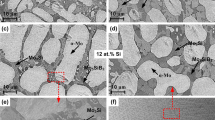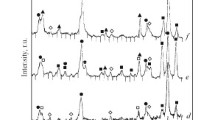Conclusions
Solid solutions in the system ZrO2-MgO fired at a high temperature (above 2000°C) in vacuo (5 · 10−4mm Hg) for 5 h decompose as a result of the complete vaporization of the MgO. Solid solutions of ZrO2-CaO undergo partial decomposition when fired in these conditions. The addition of 2 mole % or more yttrium oxide to the solid solutions ZrO2-CaO and ZrO2-MgO results in significantly lower CaO and MgO vaporization.
The long-term exposure of solid solutions in the system ZrO2-CaO and ZrO2-MgO to 2200°C in a helium atmosphere results in the formation of an intercrystalline layer in which not only the stabilizing oxide but also the impurities are concentrated.
In three-component solid solutions which contain yttrium oxide the degree of vaporization is lower and the intergranular secondary phase less developed so that the degree of collective recrystallization is lower.
Similar content being viewed by others
Literature cited
V. B. Glushkova (V. B. Glushkova), E. K. Koehler (É. K. Keler), A. K. Kusnetsov (A. K. Kuznetsov), et al., The Rare-Earth Elements, Vol. 1 [in French], National Center of Scientific Research, Paris (1970), pp. 209–220.
P. A. Tikhonov, A. K. Kuznetsov, and É. K. Keler, Neorgan. Mat.,7, No. 11, 2015–2019 (1971).
P. A. Tikhonov, A. K. Kuznetsov, É. K. Keler, et al., Dokl. Akad. Nauk SSSR,204, No. 3, 661–663 (1972).
V. B. Glushkov, A. K. Kuznetsov, and P. A. Tikhonov, in: The High-Temperature Chemistry of Silicates and Oxides [in Russian], Nauka, Leningrad (1972), pp. 52–58.
A. K. Kuznetsov, L. A. Zimina, and É. K. Keler, Neorgan. Mat.,4, No. 7, 1112–1117 (1968).
I. Pel'khovich, in: Problems of Cathode Electronics [in Russian], Gostekhizdat, Moscow (1960), pp. 125–127.
L. Birks, X-ray Microanalysis with an Electron Microprobe [in Russian], Metallurgiya, Moscow (1966).
W. H. Rhodes, J. Amer. Ceram. Soc.,44, No. 6, 300 (1961).
H. L. Hafner, N. J. Kreide, and R. A. Weidel, J. Amer. Ceram. Soc.,41, No. 8, 315–323 (1958).
T. W. Smooth and D. S. Whittemore, J. Amer. Ceram. Soc.,48, No. 3, 163–164 (1965).
A. M. Gavrish, B. Ya. Sukharevskii, E. I. Zoz, et al., Neorgan. Mat.,5, No. 6, 1103–1106 (1969).
N. A. Godina, in: Silicates and Oxides in High-Temperature Chemistry [in Russian], Izd. Akad. Nauk SSSR, Moscow (1963), pp. 215–227.
N. A. Godina and É. K. Keler, Ogneupory, No. 9, 426–431 (1961).
Author information
Authors and Affiliations
Additional information
Translated from Ogneupory, No. 8, pp. 44–48, August, 1976.
Rights and permissions
About this article
Cite this article
Kuznetsov, A.K., Tikhonov, P.A. & Keler, É.K. The effect of long-term firing at 2100–2200°C on the concentration and microstructure of solid solutions in the systems ZrO2-Y2O3-CaO and ZrO2-Y2O3-MgO. Refractories 17, 502–505 (1976). https://doi.org/10.1007/BF01282344
Issue Date:
DOI: https://doi.org/10.1007/BF01282344




